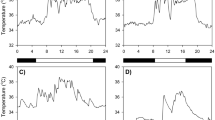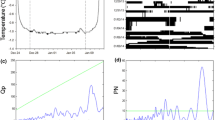Abstract
We studied daily rhythmicity of body temperature (T b) before and during hibernation in Anatolian ground squirrels (Spermophilus xanthoprymnus) under natural and laboratory conditions using surgically implanted temperature loggers. Under both conditions, robust daily T b rhythmicity with parameters comparable to those of other ground squirrel species was observed before but not during hibernation. Euthermic animals had robust daily T b rhythms with a mean of 37.0°C and a range of excursion of approximately 4°C. No T b rhythm was detected during torpor bouts, either because T b rhythmicity was absent or because the daily range of excursion was smaller than 0.2°C. The general patterns of hibernation that we observed in Anatolian ground squirrels were similar to those previously observed by other investigators in other species of ground squirrels.








Similar content being viewed by others
Abbreviations
- T b :
-
body temperature
References
Barclay RMR, Lausen CL, Hollis L (2001) What’s hot and what’s not: defining torpor in free-ranging birds and mammals. Can J Zool 79:1885–1890
Barnes BM, Ritter D (1993) Patterns of body temperature change in hibernating Arctic ground squirrels. In: Carey C, Florant GL, Wunder BA, Horwitz B (eds) Life in the cold: Ecological, physiological, and molecular mechanisms. Westview Press, Boulder, Colorado, pp 119–130
Christian N, Geiser F (2007) To use or not to use torpor? Activity and body temperature as predictors. Naturwissenschaften 94:483–487
Dunlap JC, Loros JJ, DeCoursey PJ (2004) Chronobiology: biological timekeeping. Sinauer Associates, Sunderland
French AR (1982) Intraspecific differences in the pattern of hibernation in the ground squirrel Spermophilus beldingi. J Comp Physiol 148:83–91
Geiser F (2004) Metabolic rate and body temperature reduction during hibernation and daily torpor. Annu Rev Physiol 66:239–274
Grahn DA, Miller JD, Houng VS, Heller HC (1994) Persistence of circadian rhythmicity in hibernating ground squirrels. Am J Physiol Regul Integr Comp Physiol 266:R1251–R1258
Gündüz I, Jaarola M, Tez C, Yeniyurt C, Polly PD, Searle JB (2007) Multigenic and morphometric differentiation of ground squirrels (Spermophilus, Scuiridae, Rodentia) in Turkey, with a description of a new species. Mol Phylogenet Evol 43:916–935
Gür H (2007) Morphometric variation in Anatolian ground squirrel (Spermophilus xanthoprymnus) and its relationship to selected environmental variables. PhD thesis. Hacettepe University, Ankara, Turkey
Gür H, Barlas N (2006) Sex ratio of a population of Anatolian ground squirrels (Spermophilus xanthoprymnus) in Central Anatolia, Turkey. Acta Theriol 51:61–67
Gür H, Kart Gür M (2005) Annual cycle of activity, reproduction, and body mass of Anatolian ground squirrels (Spermophilus xanthoprymnus) in Turkey. J Mammal 86:7–14
Harrison RG, Bogdanowicz SM, Hoffmann RS, Yensen E, Sherman PW (2003) Phylogeny and evolutionary history of the ground squirrels (Rodentia: Marmotinae). J Mamm Evol 10:249–276
Hudson JW (1973) Torpidity in mammals. In: Whittow GC (ed) Comparative physiology of thermoregulation. Academic Press, New York, vol 3, pp 97–165
Hut RA, Barnes BM, Daan S (2002) Body temperature patterns before, during, and after semi-natural hibernation in the European ground squirrel. J Comp Physiol B 172:47–58
Kanji GK (1993) 100 Statistical Tests. Sage, London
Karabağ T (1953) Ankara dolaylarındaki tarla sincaplarının (Citellus’ ların) biyolojisi ve bunlarla savaş usulleri [The biology of ground squirrels (Citellus) near Ankara with methods for their control]. Ankara Üniversitesi Ziraat Fakültesi Yayınları, Ankara, Turkey
Kart Gür M (2008) Hibernation pattern of Anatolian ground squirrel (Spermophilus xanthoprymnus). PhD thesis, Hacettepe University, Ankara, Turkey
Kirk RE (1995) Experimental design: procedures for the behavioral sciences, 3rd edn. Brooks/Cole, Pacific Grove
Körtner G, Geiser F (2000) The temporal organization of daily torpor and hibernation: circadian and circannual rhythms. Chronobiol Int 17:103–128
Körtner G, Song X, Geiser F (1998) Rhythmicity of torpor in a marsupial hibernator, the mountain pygmy-possum (Burramys parvus), under natural and laboratory conditions. J Comp Physiol B 168:631–638
Koukkari WL, Sothern RB (2006) Introducing biological rhythms. Springer, New York
Kryštufek B, Vohralík V (2005) Mammals of Turkey and Cyprus Rodentia I: Sciuridae, Dipodidae, Gliridae. Arvicolinea. Kniznica Annales Majora, Koper
Larkin JE, Franken P, Heller HC (2002) Loss of circadian organization of sleep and wakefulness during hibernation. Am J Physiol Regul Integr Comp Physiol 282:R1086–R1095
MacDonald DW, Amlaner CJ (1980) A practical guide to radio tracking. In: Amlaner CJ, MacDonald DW (eds) A handbook on biotelemetry and radio tracking. Pergamon Press, Oxford, pp 143–159
Michener GR (1992) Sexual differences in over-winter torpor patterns of Richardson’s ground squirrels in natural hibernacula. Oecologia 89:397–406
Nelson W, Tong YL, Lee JK, Halberg F (1979) Methods for cosinor rhythmometry. Chronobiologia 6:305–323
Refinetti R (1996) Comparison of the body temperature rhythms of diurnal and nocturnal rodents. J Exp Zool 275:67–70
Refinetti R (2004) Non-stationary time series and the robustness of circadian rhythms. J Theor Biol 227:571–581
Refinetti R (2006) Circadian physiology, 2nd edn. CRC Press, Boca Raton
Refinetti R, Cornélissen G, Halberg F (2007) Procedures for numerical analysis of circadian rhythms. Biol Rhythm Res 38:275–325
Ruby NF (2003) Hibernation: when good clocks go cold. J Biol Rhythms 18:275–286
Ruby NF, Dark J, Burns DE, Heller HC, Zucker I (2002) The suprachiasmatic nucleus is essential for circadian body temperature rhythms in hibernating ground squirrels. J Neurosci 22:357–364
Ruf T (1999) The Lomb–Scargle periodogram in biological rhythm research: analysis of incomplete and unequally spaced time-series. Biol Rhythm Res 30:178–201
Siegel AF (1980) Testing for periodicity in a time series. J Am Stat Assoc 75:345–348
Twente JW, Twente JA (1967) Seasonal variation in the hibernating behavior of Citellus lateralis. In: Fischer KC, Dawe AW, Lyman CP, Schonbaum E, South FE (eds) Mammalian hibernation III. Oliver and Boyd, Edinburg, pp 47–63
Wang LCH, Lee TF (1996) Torpor and hibernation in mammals: metabolic, physiological, and biochemical adaptations. In: Fregly MJ, Blatteis CM (eds) Handbook of physiology. Sect. 4: Environmental physiology, vol 1. Oxford University Press, New York, pp 507–532
Waßmer T, Wollnik F (1997) Timing of torpor bouts during hibernation in European hamsters (Cricetus cricetus L.). J Comp Physiol B 167:270–279
Wollnik F, Schmidt B (1995) Seasonal and daily rhythms of body temperature in the European hamster (Cricetus cricetus) under semi-natural conditions. J Comp Physiol B 165:171–182
Young PJ (1990) Hibernating patterns of free-ranging Columbian ground squirrels. Oecologia 83:504–511
Zivadinović D, Marjanović M, Andjus RK (2005) Some components of hibernation rhythms. Ann N Y Acad Sci 1048:60–68
Acknowledgments
We extend our thanks to D. Kolonkaya for the administrative management of the project. We are grateful to G. R. Michener for providing helpful comments on the field and laboratory studies. We thank the members of the Ünsal Family for their logistic support. We also thank E. Kart for assistance in the field and C. Y. Güngörmüş and H. Çakan for assistance in the laboratory. Funds for the project were provided by the Scientific and Technical Research Council of Turkey (TUBITAK, TBAG-104T279 Project). Preparation of this paper was partially supported by U.S. National Science Foundation grant IBN-0343917 to R. Refinetti.
Author information
Authors and Affiliations
Corresponding author
Additional information
Communicated by G. Heldmaier.
Rights and permissions
About this article
Cite this article
Kart Gür, M., Refinetti, R. & Gür, H. Daily rhythmicity and hibernation in the Anatolian ground squirrel under natural and laboratory conditions. J Comp Physiol B 179, 155–164 (2009). https://doi.org/10.1007/s00360-008-0298-0
Received:
Revised:
Accepted:
Published:
Issue Date:
DOI: https://doi.org/10.1007/s00360-008-0298-0




